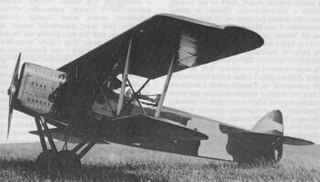
The Aero A.11 was a biplane light bomber and reconnaissance aircraft built in Czechoslovakia between the First and Second World Wars. It formed the basis for many other Czechoslovakian military aircraft of the inter-war period. Around 250 were built, with some remaining in service at the outbreak of World War II.

The Aero A.12 was a Czechoslovakian biplane light bomber and military reconnaissance aircraft manufactured in small numbers shortly after World War I. Although reminiscent of the Hansa-Brandenburg-designed aircraft that Aero was building during the war under licence as the Ae.10, the A.12 was the company's own design. It is perhaps most significant as the direct descendant of the highly successful A.11 and its various derivatives. An example of the type is preserved at the Letecké Muzeum in Kbely.

The Aero A.14 was a Czechoslovakian biplane military reconnaissance aircraft built in the 1920s. It was essentially a slightly modified version of the Hansa-Brandenburg C.I aircraft that Aero had built during World War I as the Ae.10, and for this reason, the aircraft is sometimes referred to as the A.14 Brandenburg. When equipped with a slightly different engine, the aircraft was designated A.15 instead. The two versions were otherwise almost identical.
The Aero A.19 was a biplane fighter aircraft designed in Czechoslovakia in 1923 and considered by the Czech Air Force against its stablemates the A.18 and A.20. The A.18 was selected for production and development of the A.19 was abandoned.
The Aero A.20 was a biplane fighter aircraft built in Czechoslovakia in 1923. It was evaluated for Czechoslovak Air Force service against Aero's competing A.18 and A.19 designs, a competition that the A.18 won, meaning that this aircraft never entered production, and only a single prototype was ever built.
The Aero A.21 was a biplane military trainer aircraft developed in Czechoslovakia from the Aero A.11 reconnaissance-bomber. The aircraft was developed specifically as a night-trainer, to teach Czech Air Force pilots instrument flying techniques.
The Aero A.25 was a biplane military trainer aircraft developed in Czechoslovakia from the Aero A.11 reconnaissance-bomber and generally similar to the Aero A.21 night trainer.
The Aero A.26 was a Czechoslovakian military reconnaissance biplane aircraft built by Aero Vodochody in the 1920s. It was Aero's last design to be based on the Hansa-Brandenburg B.I aircraft that the company had been building under licence during World War I as the Ae.10.

The Aero A.32 was a biplane built in Czechoslovakia in the late 1920s for army co-operation duties including reconnaissance and tactical bombing. While the design took the Aero A.11 as its starting point, the aircraft incorporated significant changes to make it suited for its new low-level role.

The Aero A.100 was a biplane light bomber and reconnaissance aircraft built in Czechoslovakia during the 1930s. It was the final step in a design lineage that extended back to the Aero A.11 a decade earlier. A.100s remained in service throughout World War II and for a few years postwar.
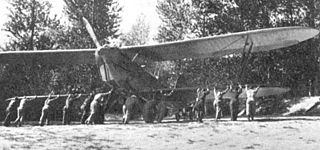
The Aero A.101 was a biplane light bomber and reconnaissance aircraft built in Czechoslovakia during the 1930s.
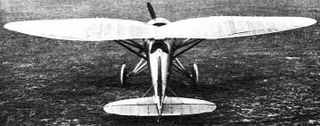
The Aero A.102 was a Czechoslovakian fighter aircraft that flew in prototype form in 1934. It was developed in response to a Czech Air Force requirement of that year, but was passed over in favour of the Avia B.35.
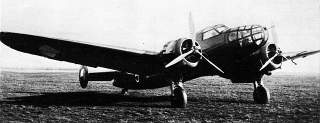
The Aero A.300 was a Czechoslovak bomber aircraft that first flew in 1938 as a much refined development of the A.304.

The Tachikawa Ki-70 "Clara" was a high speed photo reconnaissance aircraft that was tested for the Japanese Air Force in prototype form but never entered production. The Ki-70 was the intended successor to the Mitsubishi Ki-46 but was difficult to handle and was slower than the Mitsubishi Ki-46. The Ki-70 was first flown in 1943 but was found unsatisfactory and the program was terminated. Three aircraft were built.
The Letov Š-16 was a Czechoslovak single-engined, two-seat biplane bomber. It was designed by Alois Šmolík at Letov Kbely. The Š-16 first flew in 1926.
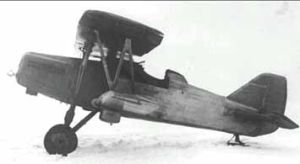
The Tupolev I-8 was an experimental interceptor built in the Soviet Union in the early 1930s.
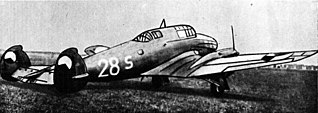
The Avia B.158 was a prototype Czechoslovak twin-engined light bomber aircraft of the 1930s. Only a single example was built and it was abandoned, following the German occupation of Czechoslovakia in March 1939.
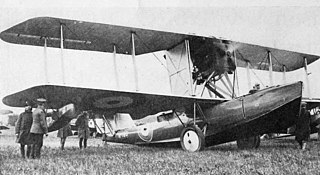
The Supermarine Sheldrake was a British amphibian biplane flying boat developed by Supermarine from the Supermarine Seagull with a revised hull. It was powered by a Napier Lion engine mounted between the wings driving a four-bladed propeller. Only one Sheldrake, serial number N180, was built.
The Breda Ba.46 was a three-engined Italian bomber transport, developed from a similar but lower-powered civil transport. It was designed in Italy in the mid-1930s for colonial policing but not put into production.
The St Croix Sopwith Triplane is an American homebuilt aircraft that was designed and produced by St Croix Aircraft of Corning, Iowa. When it was available the aircraft was supplied as a kit or in the form of plans for amateur construction. The aircraft is a full-size replica of the 1916 Sopwith Triplane fighter aircraft.
This page is based on this
Wikipedia article Text is available under the
CC BY-SA 4.0 license; additional terms may apply.
Images, videos and audio are available under their respective licenses.












